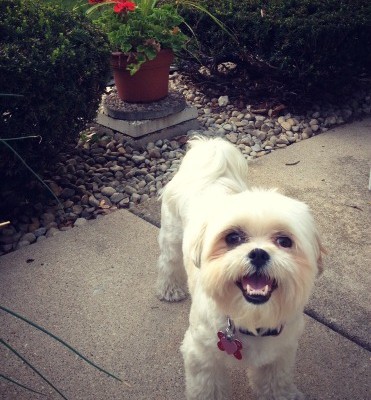October 28, 2014

We’re often asked about occasional growling, what it means, and how to react. It’s a pretty common canine behavior across all breeds, sizes, and ages but Melissa wrote in about her little gal named Molly, who grumbles at other dogs on walks. Lynda replies to her questions about how to manage her social skills and if it’s a good or bad sign.
Dear Rover-Time,
My rumbling rescue dog, Molly, is five years old and has lived with us since she was just a few months old. She’s a delightful mystery mutt that we guess is a shitzu-mix of some sort.
Molly is in her happy place when she gets out and about to explore the world. She loves an active lifestyle, but especially loves her long walks with me.
She doesn’t leave me with many questions, she’s an easy read but there is one behavior that I’m a tad concerned about and I wondered if you could help. While on leash, when we meet other dogs she gets “chatty”. Her bark doesn’t sound alarming or too nervous, but she’s vocal. Most often it sounds like a weird growl?
I want to be sure that our walks aren’t stressing her out. Besides this weird noise she makes, she’s 100% “Happy Clam”. Am I misunderstanding something? Should I correct her when she does this? Should I avoid all new dogs entirely?
Growling but graciously yours,
Melissa
Dear Melissa,
Dogs have quite a few communication tools, from the subtlest eye movement to the loudest bark. Growling is a very important and often under-appreciated part of canine communication. In general, our dogs will let us know they’re uncomfortable with the least amount of confrontation necessary.
A growl can often signal, “I’m uncomfortable, I’m trying to let you know, and if you don’t back off, I might feel the need to escalate.” As concerning as it may seem, failing to growl and taking things right to the next level would be far worse.
Often, people who punish dogs for growling are actually training out their own dog’s warning system, thereby ending up with a dog that has fewer options to advocate for themselves. This has the potential to be pretty dangerous.
In Molly’s case, she may not be so into meeting other dogs on her walk, which is not uncommon in dogs her age. The other dogs might also be doing something subtle that Miss Molly considers rude! Pay close attention to her body language when meeting other dogs. You may start to notice some very subtle signals in her body language and facial expressions that actually come before the growl. Does she tense up? Stiffen her tail? Lick her lips? Show the whites of her eyes? If you can recognize the small ways in which Molly is communicating her discomfort, you can advocate for her by moving her away from the situation so she doesn’t feel the need to growl.
Put simply, growling is a symptom of how your dog is feeling. Instead of “correcting” the growl, try to find a way to help your dog feel more comfortable. Even for the friendliest of dogs, I recommend a “5 second rule” for meeting other dogs. On your walks, limit greetings to 5 seconds and move on. This gives her a chance to sniff and be social, but perhaps not enough to be “over it.” If she starts growling at 5 seconds, go down to 3 seconds.
It seems counterintuitive to think of your rumbly pup, or Growly McGee, as being a good dog for growling. However, it’s actually very good communication! Of course, we don’t want our dogs to growl, but there are many ways to treat the cause of the growl, rather than punishing the growl itself. If Molly continues to have trouble on walks, contact a reputable and certified dog trainer or behaviorist.
Good luck and happy walking!
Big woofs,
Rover-Time
Sharing time!
Do you have a rumbly rescue?
When does your dog communicate by growling?
What have you found that helps?
Do you have a question about your pet that our Team Manager could answer? Email Lynda at lynda@rover-time.com. If she selects your question, we’ll feature it on our blog with a photo of your pet and we’ll surprise you with a little something in return as a thank you for participating! Win, win!

Recent Comments